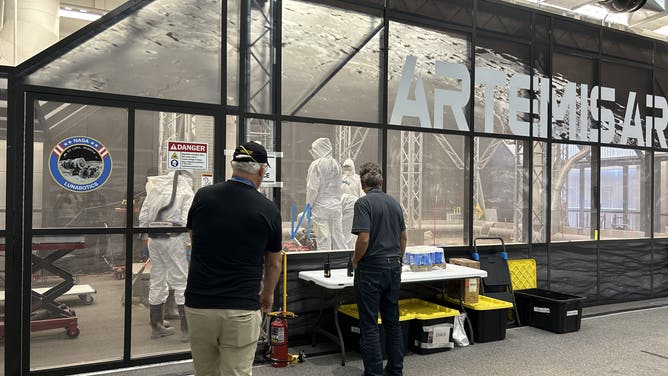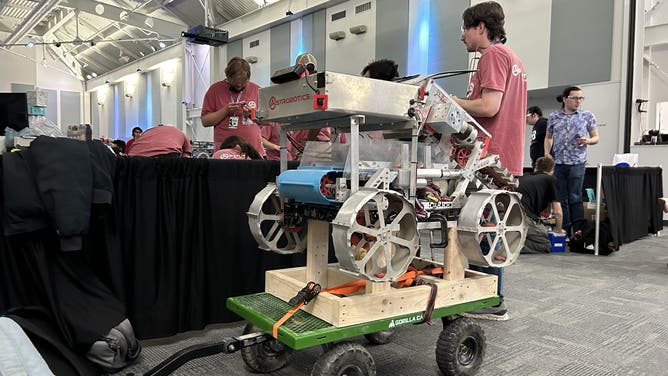College students put their lunar robots to test in NASA’s Lunabotics Competition
Ten university teams advanced to the final round of NASA's Lunabotics Competition happening near Kennedy Space Center this week. Each Moon rover will need to build a barrier to demonstrate the ability to protect lunar infrastructure for the Artemis program.
NASA's Lunabotics Competition qualifying round at UCF in Florida
More than 40 teams compete in the qualifying round of NASA's Lunabotics Competition at University of Central Florida's Exolith Lab in Orlando.
KENNEDY SPACE CENTER, Fla. – University students from around the U.S. competed in Florida this week to see how each team’s robot would fare on the surface of the Moon helping NASA's Artemis astronaut missions.
NASA’s Lunabotics competitors from 44 university teams arrived in Orlando earlier this week for a qualifying round at the University of Central Florida Exolith Lab. They tested their robots in a giant pit of artificial lunar dirt.
FAA INITIATES IMPACT STUDY FOR SPACEX MEGAROCKET LAUNCHES FROM FLORIDA
Ten teams moved on to the final round of the Lunabotics Competition at The Astronauts Memorial Foundation’s Center for Space Education at the Kennedy Space Center Visitor Complex.
The finalists include teams from Michigan Technological University, Worcester Polytechnic Institute, New Mexico Institute of Mining and Technology, the University of Alabama, University of Illinois at Chicago, Vanderbilt University, Purdue University, Iowa State University, University of Nebraska-Lincoln and the University of Utah.
EARTH’S QUASI-MOON ASTEROID KAMO'OALEWA LIKELY BLASTED OUT OF THIS GIANT MOON CRATER
In the final leg of the competition, judges will rate the teams on their autonomous rovers' ability to build a raised barrier, or berm, from lunar dirt and protect Artemis infrastructure on the Moon.
Rob Mueller, co-founder of NASA’s Swamp Works lab and the Lunabotics competition, said the challenge is a real-life circumstance in which NASA engineers will one day work on the Moon.
"We don't want to launch concrete to the Moon. So what we'll do is we'll use local resources. A lot of crushed rock on the ground. And that crushed rock is in the form of moondust," Mueller said. "So if we have a spacecraft landing, it's going to eject. There's dust everywhere. So we can build a berm or a wall out of the dirt to stop that dust from being ejected. Or we can use it for radiation shielding."
Teams have 10 minutes to set up their rovers in the Moon pit inside the Artemis Arena at the Center for Space Education.

The Artemis Arena at NASA's Lunabotics Competition at The Astronauts Memorial Foundation’s Center for Space Education at the Kennedy Space Center Visitor Complex on May 16, 2024. (Image: Emilee Speck/FOX Weather)
Students and professors don white suits, goggles and masks to enter the arena. The Moon dirt inside the pit resembles the consistency of the rocks and dirt on the actual lunar surface.
Lunar dirt is a challenging substance to navigate in, whether you are a robot or a human in a spacesuit.
It’s an intense environment in the Artemis Arena as teams watch their autonomous rovers slowly move dirt, some getting stuck or clogged with it. They only have 30 minutes to build a berm, and it usually takes every minute.
University of Alabama mechanical engineering graduate student Ben Gulledge said working on the rover during his undergraduate degree helped him find a career path.
"I've sort of taken the approach in college of trying a bunch of different things. This was the thing that I was like, ‘Give me more of that. I want more of it,'" he said.
Mueller said many of the students this week will also walk away with employment opportunities. NASA and other space industry contractors attend the event in hopes of finding prospective candidates.

The University of Alabama Astrobotics team rover at the NASA's Lunabotics Competition at The Astronauts Memorial Foundation’s Center for Space Education at the Kennedy Space Center Visitor Complex on May 16, 2024. (Image: Emilee Speck/FOX Weather)
(FOX Weather)
Outside the arena, teams have their rovers set up on tables as vacuums are going and computer dust cleaners blast away the lunar dirt. Each team has two chances to demonstrate their rover’s ability to navigate on the simulated lunar surface.
Cheers and clapping could be heard all around as everyone is eager to see each team succeed, navigating the engineering challenge before them.
By the end of the week, the University of Alabama and Iowa State University tied for the Artemis Grand Prize.
Multiple other teams also walked away with recognition from the judges for STEM Engagement, systems engineering, robotic construction and innovative technology. The University of Illinois-Chicago earned the "Failure is Not an Option Award for Team Persistence."
To view a full list of the winners of NASA's Lunabotics Challenge, click here.











